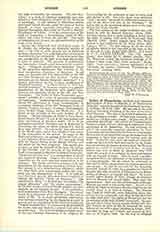

Isidore of Thessalonica, cardinal and sometime Metropolitan of Kiev or Moscow, b. at Thessalonica (Saloniki) towards the end of the fourteenth century; d. at Rome, April 27, 1463. He was one of the chief Eastern defenders of reunion at the time of the Council of Florence. The date of his birth is unknown, nor is his nationality certain. He has been variously described as a Bulgar and a Greek. In any case all his education was Greek. He arrived at Constantinople, became a monk, and was there made hegumenos of the monastery of St. Demetrius. He had evidently received an unusually complete education: he knew Latin well, and had considerable fame as a theologian. He was also an accomplished orator; he seems from the beginning to have been eager for reunion with the West. It was the time when the Court of Constantinople, on the eve of its final destruction by the Turks, was considering the chance of rescue from the Western princes as a result of reuniting with Rome. In 1434 Isidore was sent to Basle by Emperor John VIII (1425-48) as part of an embassy to open negotiations with the Council of Basle. Here he made a mellifluous speech about the splendor of the Roman Empire at Constantinople. On his return he continued to take part in all the preparations for reunion among his own people. In 1437 he was sent by the Byzantine patriarch (Joseph II, 1416-39, a conspicuous friend of reunion, who died a Catholic at Florence) to be Metropolitan of Moscow (or was his title Kiev? He is constantly called Bishop of Kiev, though he certainly went to Moscow and stayed there. They were two separate sees. Kiev was the old metropolis of Russia. Moscow was made so about this time). As soon as he arrived he began to arrange a Russian legation for the council about to be held at Ferrara. The Russian tsar, Vasili II (1425-62), made difficulties about this, and let him go eventually only after he had promised to come back with “the rights of Divine law and the constitution of the holy Church” uninjured. Syropulus and other Greek writers charge Isidore with perjury because in spite of this he accepted the union. Isidore set out with a great following on September 8, 1437, traveled by Riga and Lubeck, and arrived at Ferrara on August 15, 1438. On the way he offended his suite by his friendly conduct towards the Latins. At Ferrara and at Florence, whither the council moved in January, 1439, Isidore was one of the six chief speakers on the Byzantine side. Together with Bessarion he steadfastly worked for the union, and never swerved afterwards in his acceptance of it.
After the council, the pope (Eugene IV, 1431-47) made him his legate for all Russia and Lithuania. On his way back news reached Isidore, at Benevento, that he had been made Cardinal–Priest of the Title of St. Peter and St. Marcellinus. This is one of the few cases in which a person not of the Latin Rite has been made a cardinal. From Budapest in March, 1440, he published an encyclical calling on all Russian bishops to accept the union. But when he at last arrived in Moscow (Easter, 1441), and proclaimed the union in the Kremlin church, he found that the tsar and most of the bishops and people would have none of it. Then, at the tsar’s command, six Russian bishops met in a synod, deposed Isidore, and shut him up in prison. He escaped, fled to Rome, and was graciously received by the pope in 1443. Nicholas V (1447-55) sent him as legate to Constantinople to arrange the reunion there in 1452, and gave him two hundred soldiers to help the defense of the city. On December 12 of that year he was able to unite three hundred of the Byzantine clergy in a celebration of the short-lived reunion. He saw the taking of the city by the Turks on May 29, 1453, and only escaped the massacre by dressing up a dead body in his cardinal’s robes. While the Turks were cutting off its head and parading it through the streets, the real cardinal was shipped off to Asia Minor with a number of insignificant prisoners, as a slave. Afterwards he wrote an account of the horrors of the siege in a letter to Nicholas V (P.G., CLIX, 953). He escaped from captivity, or bought himself free, and came back to Rome. Here he was made Bishop of Sabina, presumably adopting the Latin Rite. Pius II (1458-64) later gave him two titles successively, those of Patriarch of Constantinople and Archbishop of Cyprus, neither of which he could convert into real jurisdiction. He died at Rome on April 27, 1463.
ADRIAN FORTESCUE

